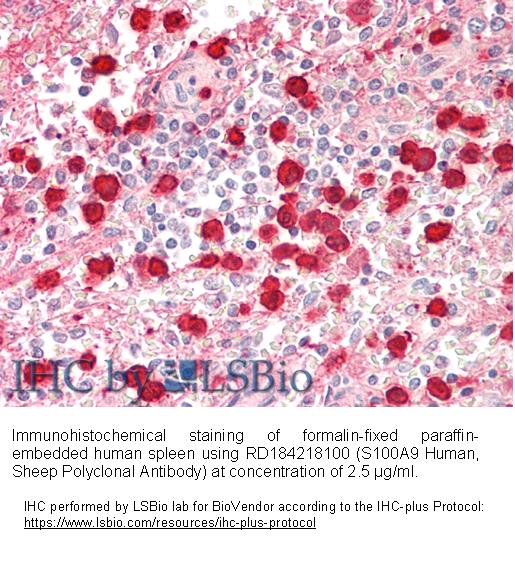Type
Polyclonal Antibody
Applications
Western blotting, ELISA, Immunohistochemistry
Antibodies Applications
Source of Antigen
E. coli
Hosts
Sheep
Preparation
The antibody was raised in sheep by immunization with the recombinant Human S100A9.
Amino Acid Sequence
The immunization antigen (14.35 kDa) is a protein containing 123 AA of recombinant Human S100A9. N-Terminal His-tag, 10 extra AA.
MKHHHHHHASTCKMSQLERNIETIINTFHQYSVKLGHPDTLNQGEFKELVRKDLQNFLKKENKNEKVIEHIMEDLDTNADKQLSFEEFIMLMARLTWASHEKMHEGDEGPGHHHKPGLGEGTP
Species Reactivity
Human. Not yet tested in other species.
Purification Method
Immunoaffinity chromatography on a column with immobilized recombinant Human S100A9.
Antibody Content
0.1 mg (determined by BCA method, BSA was used as a standard)
Formulation
The antibody is lyophilized in 0.05 M phosphate buffer, 0.1 M NaCl, pH 7.2.
Reconstitution
Add 0.2 ml of deionized water and let the lyophilized pellet dissolve completely. Slight turbidity may occur after reconstitution, which does not affect activity of the antibody. In this case clarify the solution by centrifugation.
Shipping
At ambient temperature. Upon receipt, store the product at the temperature recommended below.
Storage/Expiration
The lyophilized antibody remains stable and fully active until the expiry date when stored at -20°C. Aliquot the product after reconstitution to avoid repeated freezing/thawing cycles and store frozen at -80°C. Reconstituted antibody can be stored at 4°C for a limited period of time; it does not show decline in activity after one week at 4°C.
Quality Control Test
Indirect ELISA – to determine titer of the antibody
SDS PAGE – to determine purity of the antibody
BCA - to determine quantity of the antibody
Note
This product is for research use only.
Research topic
Coronary artery disease, Immune Response, Infection and Inflammation, Pulmonary diseases, Sepsis
Summary
S100A9 is a calcium binding protein. Each S100A9 monomer contains a high affinity calcium binding site at the C-terminus and a low-affinity calcium binding site at the N-terminus. S100A9 may exist as a homodimer, heterodimer with an S100A8 partner (S100A8/A9), or as a heterotetramer with an S100A8 partner (S100A8/A9). S100A9 was first identified in the context of multiple inflammatory reactions which has led to confusing nomenclature in the literature. In 1987, it was found in infiltrating macrophages of rheumatoid arthritis patients and named MRP-14 (myeloid related protein of molecular weight 14 kD). S100A9, a the member of the calcium binding S100 protein family that is also known as MRP14 or Calgranulin B, is an inflammation-associated protein that is constitutively expressed in neutrophils and inducible in numerous inflammatory cells, including macrophages, epithelial cells, and keratinocytes. S100A9 is located in myeloid cells, cancer cells, and in tumor stroma. S100A9 is an abundant cytoplasmic protein in normal myeloid cells such as polymorphonuclear cells and monocytes. It has become clear that S100A9 localizes with its partner S100A8 in many biological processes but may act as a sole player in other cancers. S100A8 and S100A9 are minimally expressed in normal esophageal epithelium, but S100A9 is expressed across the spectrum of Barrett’s esophagus through adenocarcinoma. S100A8 and S100A9 belong to a family of 25 homologous low-molecular-weight intracellular calcium-binding proteins that exhibit tissue and cell-specific expression. They are characterized by two distinct EF-hand (helix-loop-helix) calcium-binding domains connected by a hinge region. The N-terminal Ca 2+ binding domain has lower affinity than the canonical C-terminal domain that allows for functionally important second messenger roles dependent on intracellular Ca 2+ levels. These proteins have been associated with chronic inflammatory diseases such as rheumatoid arthritis (RA), cystic fibrosis, Crohns disease, ulcerative colitis, allergic dermatitis, and infection.

